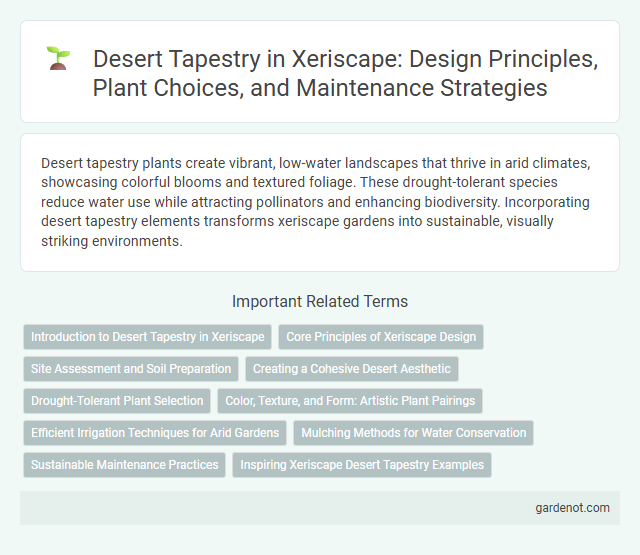Desert tapestry plants create vibrant, low-water landscapes that thrive in arid climates, showcasing colorful blooms and textured foliage. These drought-tolerant species reduce water use while attracting pollinators and enhancing biodiversity. Incorporating desert tapestry elements transforms xeriscape gardens into sustainable, visually striking environments.
Introduction to Desert Tapestry in Xeriscape
Desert tapestry refers to a diverse collection of drought-tolerant plants that create vibrant, low-water landscapes ideal for xeriscaping. These plants include native grasses, succulents, and colorful wildflowers that thrive in arid conditions, reducing water consumption while supporting local ecosystems. Incorporating desert tapestry in xeriscape design enhances soil retention and encourages biodiversity, making it a sustainable choice for water-efficient landscaping.
Core Principles of Xeriscape Design
Desert tapestry xeriscape design emphasizes water conservation through drought-tolerant plant selection, efficient irrigation strategies such as drip systems, and soil improvement for enhanced moisture retention. Incorporating native species like agave, yucca, and desert marigold reduces maintenance and supports local biodiversity. Strategic zoning of plants by water requirements optimizes resource use while creating visually appealing, sustainable landscapes.
Site Assessment and Soil Preparation
Site assessment for a desert tapestry involves analyzing soil texture, drainage patterns, and sunlight exposure to select suitable drought-tolerant plants. Soil preparation includes amending sandy or alkaline soils with organic matter to improve nutrient retention and moisture-holding capacity. Proper grading and mulching techniques help reduce erosion and maintain soil temperature in xeriscape landscapes.
Creating a Cohesive Desert Aesthetic
Desert Tapestry blends native grasses, flowering cacti, and textured succulents to create a harmonious xeriscape that embodies the rugged beauty of arid landscapes. By selecting plants like desert marigold, penstemon, and agave, the tapestry showcases a diverse color palette ranging from golden yellows to soft purples, enhancing visual interest year-round. Strategic layering of these drought-tolerant species promotes soil conservation and water efficiency while maintaining a natural yet cohesive desert aesthetic.
Drought-Tolerant Plant Selection
Desert tapestry landscapes thrive by incorporating drought-tolerant plants such as agave, yucca, and desert marigold, which conserve water while creating vibrant patterns. Selecting native species adapted to arid conditions reduces irrigation needs and supports local wildlife habitats. Strategic plant placement maximizes sun exposure and drainage, enhancing plant health and sustainability in xeriscape designs.
Color, Texture, and Form: Artistic Plant Pairings
Desert tapestry xeriscapes showcase an array of vibrant colors, blending deep reds, bright oranges, and muted greens to create dynamic visual interest. Textural contrast emerges from the pairing of spiky agave leaves with the soft, feathery foliage of desert grasses, enhancing tactile diversity. Sculptural forms such as the columnar silhouette of ocotillo complement rounded succulents, crafting a harmonious and artistic landscape design.
Efficient Irrigation Techniques for Arid Gardens
Desert tapestry landscapes thrive with efficient irrigation techniques such as drip irrigation and soaker hoses, which deliver water directly to plant roots, minimizing evaporation. Implementing soil moisture sensors ensures precise watering schedules, conserving water in arid gardens. Mulching with organic materials further reduces moisture loss and maintains soil health.
Mulching Methods for Water Conservation
Desert tapestry landscapes benefit significantly from mulching methods that enhance water conservation by reducing soil evaporation and moderating soil temperature. Organic mulches like shredded bark, compost, and wood chips improve moisture retention while slowly enriching the soil with nutrients, promoting healthy plant growth in arid environments. Inorganic mulches such as gravel and rocks also provide efficient water conservation by preventing surface runoff and minimizing weed growth, making them ideal choices for maintaining xeriscape desert tapestry gardens.
Sustainable Maintenance Practices
Desert tapestry landscapes utilize native drought-tolerant plants such as agave, sage, and yucca that require minimal watering, significantly reducing water consumption. Incorporating organic mulches and drip irrigation systems enhances soil moisture retention, preventing erosion and promoting plant health in arid climates. Sustainable maintenance practices focus on regular pruning, soil monitoring, and integrated pest management to sustain ecosystem balance and prolong the lifecycle of desert-adapted vegetation.
Inspiring Xeriscape Desert Tapestry Examples
Desert tapestry xeriscape designs showcase a vibrant blend of drought-tolerant plants such as blue grama grass, desert marigold, and penstemon, creating visually stunning landscapes with minimal water use. Examples from the Southwestern United States highlight the integration of native succulents like agave and prickly pear alongside colorful flowering shrubs like red yucca and desert sage, fostering biodiversity and resilience. These xeriscape models demonstrate how strategic plant selection and arrangement can transform arid environments into lush, sustainable outdoor spaces.
Desert tapestry Infographic

 gardenot.com
gardenot.com